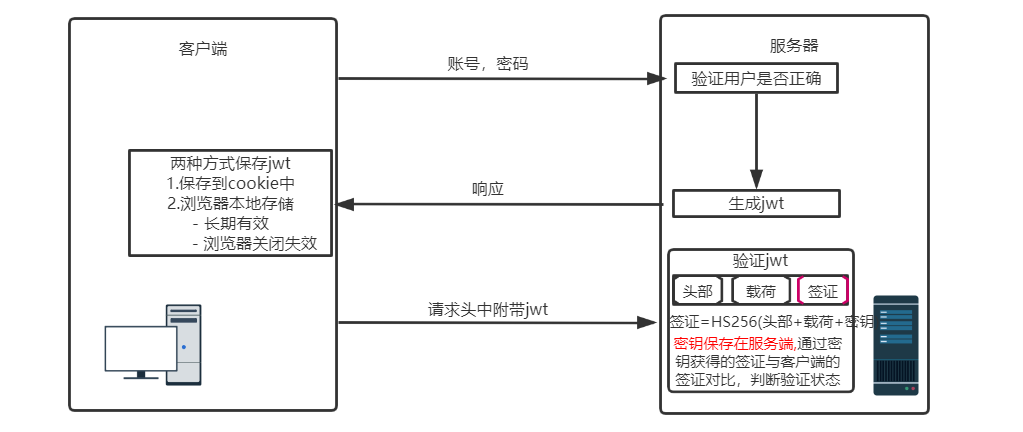
JWT(JSON Web Tokens),是一种开发的行业标准,用于安全的表示双方之间的声明。目前,jwt广泛应用在系统的用户认证方面,特别是现在前后端分离项目。
1. JWT认证流程

传统token方式和jwt在认证方面有什么差异?
1
2
| 用户登录成功后,服务端生成一个随机token给用户,并且在服务端(数据库或缓存)中保存一份token
以后用户再来访问时需携带token,服务端接收到token之后,去数据库或缓存中进行校验token的是否超时、是否合法。
|
1
2
| 用户登录成功后,服务端通过jwt生成一个随机token给用户(服务端无需保留token),
以后用户再来访问时需携带token,服务端接收到token之后,通过jwt对token进行校验是否超时、是否合法。
|
2. jwt创建token
2.1 原理
jwt的生成token格式如下,即:由 . 连接的三段字符串组成。
1
| aaaaaaaaaaa.bbbbbbbbbb.ababababababab
|
生成规则如下:
- 第一段HEADER部分,固定包含算法和token类型,对此json进行base64url加密,这就是token的第一段。
1
2
3
4
| {
"alg": "HS256",
"typ": "JWT"
}
|
- 第二段PAYLOAD,载荷部分,包含一些数据,对此json进行base64url加密,这就是token的第二段。
1
2
3
4
| {
"name":"zhan",
"age":"18"
}
|
- 第三段SIGNATURE,签证部分,把前两段的base密文通过
.拼接起来,然后对其进行HS256加密,再然后对hs256密文进行base64url加密,最终得到token的第三段。
1
2
3
4
5
6
| base64url(
HMACSHA256(
base64UrlEncode(header) + "." + base64UrlEncode(payload),
your-256-bit-secret (秘钥)
)
)
|
最后将三段字符串通过 .拼接起来就生成了jwt的token。
注意:base64url加密是先做base64加密,然后再将 - 替代 + 及 _ 替代 / 。
加密过程的部分源码:
1
2
3
4
5
6
7
8
9
10
11
12
13
14
15
16
17
18
19
20
21
22
23
24
| jwt.encode()
def encode(self,
payload,
key,
algorithm='HS256',
headers=None,
json_encoder=None
):
segments = []
header = {'typ': self.header_typ, 'alg': algorithm}
segments.append(base64url_encode(json_header))
segments.append(base64url_encode(payload))
signing_input = b'.'.join(segments)
try:
alg_obj = self._algorithms[algorithm]
key = alg_obj.prepare_key(key)
signature = alg_obj.sign(signing_input, key)
segments.append(base64url_encode(signature))
return b'.'.join(segments)
|
2.2 代码实现
基于Python的pyjwt模块创建jwt的token。
1
2
3
4
5
6
7
8
9
10
11
12
13
14
15
16
17
18
19
20
21
| import jwt
import datetime
from jwt import exceptions
SALT = 'iv%x6xo7l7_u9bf_u!9#g#m*)*=ej@bek5)(@u3kh*72+unjv='
def create_token():
headers = {
'typ': 'jwt',
'alg': 'HS256'
}
payload = {
'user_id': 1,
'username': 'wupeiqi',
'exp': datetime.datetime.utcnow() + datetime.timedelta(minutes=5)
}
result = jwt.encode(payload=payload, key=SALT, algorithm="HS256", headers=headers).decode('utf-8')
return result
if __name__ == '__main__':
token = create_token()
print(token)
|
3. jwt校验token
一般在认证成功后,把jwt生成的token返回给用户,以后用户再次访问时候需要携带token,此时jwt需要对token进行超时及合法性校验。
将token分割成 header_segment、payload_segment、crypto_segment 三部分
1
2
3
4
5
6
7
8
9
10
11
12
13
14
| jwt_token = "eyJhbGciOiJIUzI1NiIsInR5cCI6IkpXVCJ9.eyJzdWIiOiIxMjM0NTY3ODkwIiwibmFtZSI6IkpvaG4gRG9lIiwiaWF0IjoxNTE2MjM5MDIyfQ.SflKxwRJSMeKKF2QT4fwpMeJf36POk6yJV_adQssw5c"
signing_input, crypto_segment = jwt.rsplit(b'.', 1)
header_segment, payload_segment = signing_input.split(b'.', 1)
header_data = base64url_decode(header_segment)
payload = base64url_decode(payload_segment)
signature = base64url_decode(crypto_segment)
try:
alg_obj = self._algorithms[alg]
key = alg_obj.prepare_key(key)
if not alg_obj.verify(signing_input, key, signature):
raise InvalidSignatureError('Signature verification failed')
|
对第一部分header_segment进行base64url解密,得到header
对第二部分payload_segment进行base64url解密,得到payload
对第三部分crypto_segment进行base64url解密,得到signature
对第三部分signature部分数据进行合法性校验
- 拼接前两段密文,即:
signing_input
- 从第一段明文中获取加密算法,默认:
HS256
- 使用 算法+密钥 对
signing_input 进行加密,将得到的结果即签证和signature密文进行比较。
DEMO
1
2
3
4
5
6
7
8
9
10
11
12
13
14
15
16
17
18
19
20
21
22
23
24
25
| import jwt
import datetime
from jwt import exceptions
def get_payload(token):
"""
根据token获取payload
:param token:
:return:
"""
try:
verified_payload = jwt.decode(token, SALT, True)
return verified_payload
except exceptions.ExpiredSignatureError:
print('token已失效')
except jwt.DecodeError:
print('token认证失败')
except jwt.InvalidTokenError:
print('非法的token')
if __name__ == '__main__':
token = "eyJhbGciOiJIUzI1NiIsInR5cCI6IkpXVCJ9.eyJleHAiOjE1NzM1NTU1NzksInVzZXJuYW1lIjoid3VwZWlxaSIsInVzZXJfaWQiOjF9.xj-7qSts6Yg5Ui55-aUOHJS4KSaeLq5weXMui2IIEJU"
payload = get_payload(token)
|
4. jwt实战
在用户登录成功之后,生成token并返回,用户再次来访问时需携带token。
此示例在django的中间件中对tokne进行校验,内部编写了两个中间件来支持用户通过两种方式传递token。
1
| http://www.xxxxx.com?token=eyJhbGciOiJIUzI1N...
|
1
2
3
| GET /something/ HTTP/1.1
Host: pythonav.com
Authorization: JWT eyJhbGciOiAiSFMyNTYiLCAidHlwIj
|
drf示例
view.py
1
2
3
4
5
6
7
8
9
10
11
12
13
14
15
16
17
18
19
20
21
22
23
24
25
26
27
28
29
30
31
32
33
34
35
| from rest_framework.views import APIView
from rest_framework.response import Response
from utils.jwt_auth import create_token
from extensions.auth import JwtQueryParamAuthentication, JwtAuthorizationAuthentication
class LoginView(APIView):
def post(self, request, *args, **kwargs):
""" 用户登录 """
user = request.POST.get('username')
pwd = request.POST.get('password')
if user == 'zhan' and pwd == '123':
token = create_token({'username': 'zhan'})
return Response({'status': True, 'token': token})
return Response({'status': False, 'error': '用户名或密码错误'})
class OrderView(APIView):
authentication_classes = [JwtQueryParamAuthentication, ]
def get(self, request, *args, **kwargs):
print(request.user, request.auth)
return Response({'data': '订单列表'})
def post(self, request, *args, **kwargs):
print(request.user, request.auth)
return Response({'data': '添加订单'})
|
utils\jwt_auth.py
1
2
3
4
5
6
7
8
9
10
11
12
13
14
15
16
17
18
19
20
21
22
23
24
25
26
27
28
29
30
31
32
33
34
35
36
37
38
39
40
41
42
|
import jwt
import datetime
from jwt import exceptions
JWT_SALT = 'iv%x6xo7l7_u9bf_u!9#g#m*)*=ej@bek5)(@u3kh*72+unjv='
def create_token(payload, timeout=20):
"""
:param payload: 例如:{'user_id':1,'username':'wupeiqi'}用户信息
:param timeout: token的过期时间,默认20分钟
:return:
"""
headers = {
'typ': 'jwt',
'alg': 'HS256'
}
payload['exp'] = datetime.datetime.utcnow() + datetime.timedelta(minutes=timeout)
result = jwt.encode(payload=payload, key=JWT_SALT, algorithm="HS256", headers=headers).decode('utf-8')
return result
def parse_payload(token):
"""
对token进行和发行校验并获取payload
:param token:
:return:
"""
result = {'status': False, 'data': None, 'error': None}
try:
verified_payload = jwt.decode(token, JWT_SALT, True)
result['status'] = True
result['data'] = verified_payload
except exceptions.ExpiredSignatureError:
result['error'] = 'token已失效'
except jwt.DecodeError:
result['error'] = 'token认证失败'
except jwt.InvalidTokenError:
result['error'] = '非法的token'
return result
|
extensions/auth.py
1
2
3
4
5
6
7
8
9
10
11
12
13
14
15
16
17
18
19
20
21
22
23
24
25
26
27
28
29
30
31
32
33
34
35
36
37
38
39
40
41
42
43
44
45
46
47
48
49
50
51
|
from rest_framework.authentication import BaseAuthentication
from rest_framework import exceptions
from utils.jwt_auth import parse_payload
class JwtQueryParamAuthentication(BaseAuthentication):
"""
用户需要在url中通过参数进行传输token,例如:
http://www.pythonav.com?token=eyJhbGciOiJIUzI1NiIsInR5cCI6IkpXVCJ9.eyJleHAiOjE1NzM1NTU1NzksInVzZXJuYW1lIjoid3VwZWlxaSIsInVzZXJfaWQiOjF9.xj-7qSts6Yg5Ui55-aUOHJS4KSaeLq5weXMui2IIEJU
"""
def authenticate(self, request):
token = request.query_params.get('token')
payload = parse_payload(token)
if not payload['status']:
raise exceptions.AuthenticationFailed(payload)
return (payload, token)
class JwtAuthorizationAuthentication(BaseAuthentication):
"""
用户需要通过请求头的方式来进行传输token,例如:
Authorization:jwt eyJhbGciOiJIUzI1NiIsInR5cCI6IkpXVCJ9.eyJleHAiOjE1NzM1NTU1NzksInVzZXJuYW1lIjoid3VwZWlxaSIsInVzZXJfaWQiOjF9.xj-7qSts6Yg5Ui55-aUOHJS4KSaeLq5weXMui2IIEJU
"""
def authenticate(self, request):
authorization = request.META.get('HTTP_AUTHORIZATION', '')
auth = authorization.split()
if not auth:
raise exceptions.AuthenticationFailed({'error': '未获取到Authorization请求头', 'status': False})
if auth[0].lower() != 'jwt':
raise exceptions.AuthenticationFailed({'error': 'Authorization请求头中认证方式错误', 'status': False})
if len(auth) == 1:
raise exceptions.AuthenticationFailed({'error': "非法Authorization请求头", 'status': False})
elif len(auth) > 2:
raise exceptions.AuthenticationFailed({'error': "非法Authorization请求头", 'status': False})
token = auth[1]
result = parse_payload(token)
if not result['status']:
raise exceptions.AuthenticationFailed(result)
return (result, token)
|



